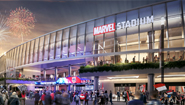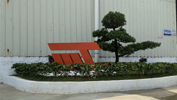Harnessing the Power of Windproof Aluminum in Modern Architecture
Author:Jayminton Time:2024-07-22

In the realm of modern architecture, where innovation and functionality converge, materials play a pivotal role in shaping the landscape of design possibilities. One such material that has garnered significant attention and admiration is windproof aluminum. Renowned for its versatility, durability, and aesthetic appeal, windproof aluminum has become a cornerstone in contemporary architectural practices around the globe.
Strength and Durability
At the heart of windproof aluminum's appeal lies its remarkable strength-to-weight ratio. Aluminum, inherently lightweight yet incredibly robust, offers architects the flexibility to design structures that are both visually striking and structurally sound. This material is particularly valued for its ability to withstand the forces of nature, including wind loads and extreme weather conditions, making it an ideal choice for buildings in various climates.
Versatility in Design
Architects are continually pushing the boundaries of design, seeking materials that can adapt to their creative visions. Windproof aluminum, with its malleability and formability, allows for the realization of complex geometries and innovative shapes. From sleek, minimalist Facades to intricate, futuristic structures, aluminum facilitates the creation of architectural marvels that capture the imagination.
Sustainability and Efficiency
In an era increasingly defined by environmental consciousness, the sustainability of building materials is a critical consideration. Aluminum, derived from bauxite ore through a highly energy-efficient process, boasts impressive recyclability. This characteristic not only reduces the environmental footprint of construction but also aligns with sustainable building practices, making it a preferred choice for eco-conscious architects and developers.
Thermal Performance
Beyond its structural prowess, windproof aluminum contributes to the energy efficiency of buildings. When properly insulated, aluminum effectively minimizes heat transfer, thereby enhancing thermal performance and reducing the overall energy consumption required for heating and cooling. This attribute not only improves comfort for occupants but also contributes to long-term operational savings and sustainability goals.
Maintenance and Longevity
Another hallmark of windproof aluminum is its low maintenance requirements and longevity. Unlike some traditional building materials, aluminum is resistant to corrosion and degradation, ensuring that structures retain their aesthetic appeal and structural integrity over time. This durability translates into reduced lifecycle costs and enhanced reliability, factors that are particularly advantageous in commercial and residential developments alike.
Applications in Architecture
The applications of windproof aluminum in architecture are as diverse as they are impressive. From high-rise office buildings and residential towers to cultural institutions and public spaces, aluminum’s adaptability ensures its relevance across various scales and contexts. Its ability to seamlessly integrate with other materials further expands its architectural possibilities, offering designers a palette of options to achieve their desired aesthetic and functional objectives.
Conclusion
In conclusion, windproof aluminum stands as a testament to the symbiosis of innovation and tradition in modern architecture. Its blend of strength, versatility, sustainability, and aesthetic appeal makes it a material of choice for architects seeking to redefine the boundaries of what is possible in building design. As technology and design continue to evolve, windproof aluminum is poised to remain a cornerstone of architectural excellence, shaping skylines and inspiring communities for generations to come.

 S1 Clip-in Metal ceiling System
S1 Clip-in Metal ceiling System JMT-L4.2 U-Baffle System
JMT-L4.2 U-Baffle System JMT Aluminum Wall Cladding
JMT Aluminum Wall Cladding Aluminum Honeycomb Panel
Aluminum Honeycomb Panel Air-Condenser Cover
Air-Condenser Cover Metal Heat Cover
Metal Heat Cover Singapore Changi Airport T2 Arrival
Singapore Changi Airport T2 Arrival Australia Marvrl Stadium City Edge
Australia Marvrl Stadium City Edge Enterprise Information Announcement
Enterprise Information Announcement Construction Industry Solutions
Construction Industry Solutions About Jayminton
About Jayminton Contact US
Contact US